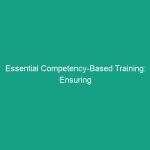Introduction
In today’s fast-paced work Environment, the importance of Health and Safety Risk Management cannot be overstated. Organizations face various challenges, from regulatory compliance to employee well-being. Understanding and implementing effective health and Safety practices not only protects employees but also promotes a culture of safety that can lead to increased productivity and morale. This article aims to explore essential guidelines that are vital for successful health and safety risk management.
By prioritizing health and Safety Measures, businesses can mitigate risks, comply with legal frameworks, and ultimately create a safer workplace. This article will delve into the regulatory frameworks surrounding health and safety, best practices for effective risk management, insightful case studies, common challenges, and future trends that could impact how organizations approach Workplace Safety.
Regulatory Frameworks for Health and Safety
Understanding the regulatory frameworks governing health and safety is crucial for effective Health and Safety Risk Management. Different countries have varying laws and Regulations, but the common goal is to protect employees and ensure safe working conditions.
International Standards and Guidelines
At the international level, organizations such as the International Labour Organization (ILO) and the World Health Organization (WHO) provide guidelines that influence national regulations. These bodies emphasize the importance of Occupational Health and safety (OHS) and advocate for comprehensive systems that manage risks effectively. For example, the ILO’s Occupational Safety and Health Convention, 1981 (No. 155), encourages member states to develop national policies on occupational safety and health, ensuring that risk management is at the forefront of workplace Safety Strategies.
National Regulations
In the United States, the Occupational Safety and Health Administration (OSHA) sets the standards for Workplace Safety. osha‘s regulations cover a wide range of industries and emphasize the need for employers to provide a safe working environment. Non-compliance can lead to severe penalties, making it essential for organizations to be well-versed in these regulations. In the European Union, the Framework Directive 89/391/EEC lays down general principles for the Prevention of occupational risks, reinforcing employers’ responsibilities in safeguarding employee health.
Industry-Specific Regulations
Many industries have specific regulations tailored to their unique risks. For instance, the construction industry is governed by stringent safety laws due to the high-risk nature of the work. Understanding these industry-specific regulations allows organizations to implement targeted Safety Measures that address the unique challenges faced in their respective sectors.
Best Practices in Health and Safety Risk Management
Implementing Best Practices in Health and Safety Risk Management is essential for fostering a culture of safety within an organization. Here are some key strategies to consider:
Risk Assessment and Management
A robust risk assessment process is the cornerstone of effective health and safety management. This involves identifying potential Hazards, assessing the risks they pose, and implementing Control Measures to mitigate them. Organizations should conduct regular risk assessments to ensure that new Hazards are identified and addressed promptly. The use of risk assessment tools and methodologies, such as the Hierarchy of Controls, can guide organizations in prioritizing interventions based on their effectiveness.
Employee Training and Engagement
Training employees on health and safety protocols is vital for ensuring compliance and fostering a culture of safety. Organizations should provide regular training sessions that cover safety Procedures, emergency response plans, and the proper use of Personal Protective Equipment (PPE). Engaging employees in the development of safety programs can also enhance their commitment to safety practices, creating a shared responsibility for maintaining a safe workplace.
Incident Reporting and Investigation
Establishing a clear incident reporting system is crucial for identifying patterns and preventing future incidents. Employees should feel encouraged to report near misses and accidents without fear of repercussions. Analyzing incidents through thorough investigations can uncover root causes and lead to improvements in safety protocols. Organizations can use this information to refine their risk management strategies continually.
Safety Culture Development
Developing a positive safety culture requires leadership commitment and employee involvement. Leaders should model safe behaviors and prioritize safety in all decision-making processes. Moreover, involving employees in safety committees or initiatives can empower them and foster a sense of ownership over Workplace Safety. A strong safety culture not only enhances compliance but also improves overall employee morale and productivity.
Case Studies: Successful Health and Safety Risk Management
Learning from real-world examples can provide valuable insights into effective Health and Safety Risk Management. Below are case studies of organizations that successfully implemented health and safety initiatives.
Case Study 1: DuPont’s Safety Transformation
DuPont, a leader in the chemical industry, faced numerous safety challenges in the early 2000s. To address these issues, the company implemented a comprehensive safety management system that focused on risk assessment, employee engagement, and continuous improvement. By integrating safety into their corporate culture and providing extensive training, DuPont reduced its injury rates significantly, demonstrating that a proactive approach to safety can yield substantial Benefits.
Case Study 2: British Airways’ Safety Management System
British Airways recognized the importance of safety management in maintaining operational efficiency. The airline adopted a Safety Management System (SMS) that emphasized risk management and safety performance monitoring. By utilizing data analytics to track safety metrics and incidents, British Airways improved its safety outcomes and enhanced its operational resilience. This case illustrates how leveraging technology can improve health and safety practices in complex environments.
Challenges in Health and Safety Risk Management
Despite the best intentions, organizations often face challenges in implementing effective Health and Safety Risk Management practices. Identifying these challenges is the first step toward overcoming them.
Compliance Burdens
Navigating the complex landscape of health and safety regulations can be overwhelming for organizations, especially for small and medium-sized enterprises (SMEs). The constant updates to regulations require ongoing training and adaptation, which can strain resources. Organizations must prioritize compliance while ensuring that safety remains a core value, not just a checkbox.
Cultural Resistance
Changing workplace culture to prioritize health and safety can be met with resistance. Employees may be accustomed to certain practices that are not safe, and altering these behaviors requires time and effort. Organizations can address this resistance by clearly communicating the benefits of safety measures and involving employees in the decision-making process to foster buy-in.
Resource Limitations
Many organizations struggle with limited resources for health and safety initiatives. This can hinder the implementation of comprehensive training, safety equipment, and risk management strategies. To address this challenge, organizations should identify areas where they can optimize existing resources, such as leveraging technology for training or collaborating with other organizations to share safety resources.
Future Trends in Health and Safety Risk Management
The field of health and safety risk management is continuously evolving, influenced by technological advancements, regulatory changes, and shifting workforce dynamics. Here are some future trends to watch:
Technological Integration
Technology will play an increasingly vital role in health and safety practices. Innovations such as wearable safety devices, mobile apps for reporting incidents, and data analytics for risk assessment are transforming how organizations approach safety. Companies that embrace these technologies will be better equipped to manage risks and enhance employee safety.
Focus on Mental Health
Understanding the importance of mental health in the workplace is gaining traction. Organizations are recognizing that mental well-being is just as critical as physical safety. Implementing programs that support mental health, such as stress management workshops and employee assistance programs, is becoming a key component of comprehensive health and safety strategies.
Remote Work Safety
With the rise of remote work, organizations must adapt their health and safety strategies to address the unique challenges of home-based work environments. Employers should provide guidelines for safe home office setups and promote ergonomic practices to prevent injuries. Additionally, maintaining open lines of communication about mental health and well-being is crucial in remote work settings.
Conclusion
Effective Health and Safety Risk Management is essential for protecting employees and fostering a safe workplace environment. By understanding regulatory frameworks, implementing Best Practices, learning from case studies, addressing challenges, and embracing future trends, organizations can enhance their health and safety efforts. As we move forward, the commitment to prioritizing health and safety will not only protect employees but will also contribute to the overall success and Sustainability of organizations.
To ensure a safer workplace, it is essential to take proactive steps in health and safety practices. Start by assessing your current safety measures, engaging employees, and continually refining your approach. Remember, safety is not just a requirement; it is a shared responsibility and a foundation for a thriving workplace.


